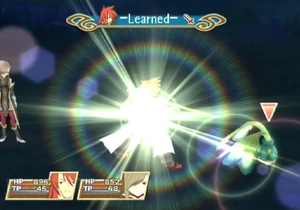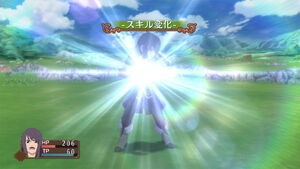
Learning a new move in Tales of the Abyss.
Arte (術技 Jutsuwaza?, "Magic Ability") is the term used to refer to all named attacks and spells in all Tales games. In the English context, this term originated in Tales of Eternia, referring to the Craymel Artes system for spells obtained through fringing Craymel Cages together. Other terms such as Skill and Technique were used as a translation for this concept in past games, but in Tales of the Abyss, the term "arte" was extended to include all named battle movements, while "skill" was designated to refer to only passive effects. Parallel concepts exist in Tales of Rebirth and Tales of Legendia, which refer to artes as Force and Eres respectively, due to the significance of these concepts in their stories.
Strike Artes
A strike arte (技 Waza?, "Ability") typically involves direct and physical interaction of a weapon or the user's body with the enemy. Depending on the amount of TP consumed and the damage output, these are often divided into three tiers: base, master, and arcane artes. All artes of each subset can be linked together in this order to create a combo chain. Certain passive skills may be used to alter this order, providing more freedom and creativity for players to create their own combo patterns. Some games remove the master arte category, which can limit the comboing potential, but there may be other additional arte groupings that are exclusive to certain games.
Base Artes
Base artes (特技 Tokugi?, "Special Abilities") are usually learned as a character progresses through leveling up during the game, and sometimes through events and sidequests. Base artes consume a very minimal amount of TP, dealing a slightly increased amount of damage compared to a regular attack. These artes can be performed individually, but it is more efficient to attack enemies first with a regular attack combo, linking the base arte to the end of the chain to prevent lag time. Some examples of these artes include Demon Fang and Tiger Blade.
Base artes can also include self-supporting artes that can be activated instantly and without casting time. They can be used to heal or to provide small but useful stat gains for a short period of time. Certain self-supporting artes can damage nearby enemies, such as the altered version of Fiend Fusion, but these artes are usually unable to link into other artes within a combo. Examples include Coil and Center.
Master Artes

Learning a new move in Tales of Vesperia.
Artes of the master artes (秘技 Higi?, "Secret Abilities") subset are more powerful than the base artes, but they come at a price of higher TP cost. Master artes usually derive from existing base artes, so mastery of the original base is often required to obtain the next arte within the same family. These artes can be linked to the end of any combo chain if it is immediately preceded by a regular attack or base arte. Continuing from the above example, the associated master artes are Double Demon Fang and Tiger Rage, respectively.
Arcane Artes
Arcane artes (奥義 Ougi?, "Inner Meaning") are the final rank for all strike artes, representing the most powerful artes that are available to a character that relies on physical attacks to damage enemies. TP costs can become significant if these artes are used too often, but the costs are usually worth the ability to prolong a combo and deal even more damage before the enemy has a chance to recover. Like the previous master artes, this tier of attacks usually builds upon the same family of artes, requiring mastery of the previous forms. To conclude the previous example, the final arcane arte forms are Demonic Chaos and Rending Tiger Blade.
Some arcane artes are derived from the combination of two existing artes, which can be both physical or magical in nature. The artes are fused together to form a new arte, using the components of the two bases to create a single combined attack. The arte names usually reflect this fusion by referencing the original bases. These artes usually require both bases to be mastered before the combined variant can be learned. Examples of these combination artes include Demonic Tiger Blade, which is based on Demon Fang and Tiger Blade, and Fang Blade Havoc, which combines Fang Blade and Havoc Strike.
Arcane artes can also include certain attacks that do not have a base in any of the lesser tiers. These artes can be learned by level or event, and they usually have a significantly lesser TP cost than those that follow the usual progression of power or combination. These artes might not be easily added to a combo chain, but they can have their uses. Examples include Guardian Field and Rising Phoenix.
Magic Artes
Magic artes (術 Jutsu?, "Magic"), also known as spells, are used by characters who have the knowledge and ability to perform magical feats. Spellcasters are usually tied to some limiting condition that enables them to possess these powers, such as the use of a Swordian or the hereditary blood of the Elven race. Unlike strike artes, spells do not directly affect battle immediately following activation. The character usually recites an incantation before casting, limiting the speed by which they can deal damage to the enemy. Spells use TP after they have been cast, not during the incantation. By default, characters that are attacked during the incantation will be interrupted and the spell will not activate. However, with the use of certain passive skills, characters can have some resistance or even immunity to casting interruptions.
There are several names for magic artes depending on their usage and what powers them. Tales of Eternia, for example, names them Craymel Artes (晶霊術 Shoureijutsu?, "Crystal Spirit Artes") because they are empowered by Craymels, elemental spirits in the world symbolized by crystal shards, while in Tales of the Abyss, all spells are referred to as Fonic Artes (譜術 Fujutsu?, "Chanted Magic") because they use fonons, the fundamental particle in their world. Tales of Destiny and Tales of Destiny 2 prefer the term Shoujutsu (晶術?, "Crystal Magic") in reference to the lens that dominate their world's history. Tales of Phantasia makes the distinction between the various types of magic based on their origin. It uses Magic (魔術 Majutsu?, "Arcane Magic") for spells which draw their power from mana, while differentiating Divine Power (法術 Houjutsu?, "Divine Magic") as spells derived from prayer. Summoning (召喚術 Shoukanjutsu?, "Summoning Magic") calls upon elemental Spirits to aid battle for a short time, gained after forming pacts with the Spirits themselves. Certain games may have more specialized terms for particular forms of magic that are unique to their stories, such as Angel Skills (天使術 Tenshijutsu?, "Angelic Magic") in Tales of Symphonia and Fonic Hymns (音素譜歌 Onsofuka?) in Tales of the Abyss.
In addition to the following methods, they may also be classified as novice, intermediate, and advanced, following a tier system similar to that which is used by strike artes to organize spells into groupings based on damage output, TP cost, and casting time.
Offensive Magic
Offensive magic represents the usual method used by spellcasters to deal damage to enemies. These artes consume more TP than physical strike artes, but they can be used to hit a large number of enemies within an area of effect with proper coordination and timing. They usually deal more damage than physical attacks, but the more powerful spells are countered by longer casting times, followed by a startup lag that further delays the damage output. Some examples include Fire Ball and Indignation.
Healing/Support/Recovery Magic
These spells are used to assist party members by offering temporary increased stats or reversing status ailments. These spells are more passive in nature, usually intended to cure and prevent enemy damage, or even to inflict damage to the enemy indirectly through de-buffs and other harmful conditions, to provide a better advantage for the party as a whole. Primary examples include First Aid and Barrier.
Summons
These are special incantations that enable an elemental deity, known as a Summon Spirit, to be called into the battle temporarily to deal heavily concentrated damage or provide beneficial support to all allies. Summons can be activated only after several conditions are met, which can vary between each game. The summons can deal a very large amount of damage beyond the capability of most spells, but this is countered by their rare availability during battles. These summoned allies include Sylph and Celsius. The exceptions to this rule include Tales of Phantasia, Tales of Graces, and Tales of Xillia, in which the summons can be treated either as traditional spells or as physical artes.
Other Arte Concepts
Mystic Artes
Mystic artes (秘奥義 Hi Ougi?, "Hidden Inner Meaning") are typically rare and powerful artes that are unique to a given character within each game, usually accompanied with an anime-style facial or full-body cut-in of the character. These artes can be activated during battle while Over Limit mode is active, usually after performing an arcane arte and holding the "Attack" button, extending and linking into the mystic arte automatically. Other games may have alternative methods for activating mystic artes, sometimes exceedingly difficult to perform successfully to counter the significantly increased damage output.
Altered Artes
Altered artes (術技変化 Jutsuwaza Henka?, "Magic Ability Change") are artes which have been modified from another arte through some equipment or circumstance. FOF Changes (FOF変化 FOF Henka?) can be seen as a similar system. The altered artes concept was first used in Tales of Symphonia, where dealing elemental damage can turn some artes into others. For example, Lloyd Irving's Rising Falcon can turn into the classic Rising Phoenix while dealing Fire-elemental damage.
Combination Artes
Combination artes are a general term for artes that require the presence of a pair of characters to perform a certain combined attack that merges two of their own artes. This concept has appeared throughout the series with multiple variations in requirement and execution, first originating in Tales of Eternia with its Team Skills (協力技 Kyouryokuwaza?). The concept of merging two characters' artes together has been fleshed out progressively more with each game, leading to the Compound Special Attack (複合特技 Fukugou Tokugi?) system used during a Unison Attack in Tales of Symphonia, the Combination Artes (合技 Gougi?) of Tales of Hearts, and eventually the Linked Arte (共鳴術技「リンクアーツ」 Kyoumei Jutsuwaza?, "Link Artes") system in Tales of Xillia and Tales of Xillia 2.
Commonly recurring combinations include Hell Pyre, as a combination of Tiger Blade and Fire Ball, and Impact Cross, as a combination of two characters' Sonic Thrust. This concept has since been expanded to include mystic artes, leading to the development of artes such as Celsius Calibur and Kogahazan Agito.
Trivia
- For many games, Japanese arte names have a sort of naming consistency. In general, spells are foreign words written in katakana. These are often English words or phrases, though some, such as Eclair de Larmes, derive from other Western languages. As a reverse, many traditional strike artes use kanji and the On'yomi pronunciation. Strike artes that are derived from base forms of earlier tiers often incorporate the names of the original artes into the new arte name.
